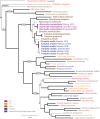A phylogeny of the Triraphideae including Habrochloa and Nematopoa (Poaceae, Chloridoideae)
- PMID: 35586318
- PMCID: PMC9038846
- DOI: 10.3897/phytokeys.194.80967
A phylogeny of the Triraphideae including Habrochloa and Nematopoa (Poaceae, Chloridoideae)
Abstract
To investigate the evolutionary relationships among species of the tribe Triraphideae (including two monotypic genera, Habrochloa and Nematopoa), we generated a phylogeny based on DNA sequences from nuclear ribosomal (ITS) and four plastid markers (rps16-trnK, rps16 intron, rpl32-trnL, and ndhA intron). Habrochloa and Nematopoa form a clade that is sister to Neyraudia and Triraphis. Member of the Triraphideae have paniculate inflorescences, 3-veined, marginally ciliate lemmas, usually with hairy lateral veins, that are apically bifid and awned from between a sinus. A description of the Triraphideae and key to the genera is provided, and the biogeography is discussed, likely originating in Africa.
Keywords: Classification; Habrochloa; Nematopoa; Neyraudia; Triraphideae; Triraphis; molecular phylogenetics.
Figures

Similar articles
-
A classification of the Chloridoideae (Poaceae) based on multi-gene phylogenetic trees.Mol Phylogenet Evol. 2010 May;55(2):580-98. doi: 10.1016/j.ympev.2010.01.018. Epub 2010 Jan 22. Mol Phylogenet Evol. 2010. PMID: 20096795
-
A phylogeny and classification of the Muhlenbergiinae (Poaceae: Chloridoideae: Cynodonteae) based on plastid and nuclear DNA sequences.Am J Bot. 2010 Sep;97(9):1532-54. doi: 10.3732/ajb.0900359. Epub 2010 Aug 23. Am J Bot. 2010. PMID: 21616906
-
A molecular phylogeny and classification of Leptochloa (Poaceae: Chloridoideae: Chlorideae) sensu lato and related genera.Ann Bot. 2012 Jun;109(7):1317-30. doi: 10.1093/aob/mcs077. Ann Bot. 2012. PMID: 22628365 Free PMC article.
-
Allotetraploid origin and divergence in Eleusine (Chloridoideae, Poaceae): evidence from low-copy nuclear gene phylogenies and a plastid gene chronogram.Ann Bot. 2011 Nov;108(7):1287-98. doi: 10.1093/aob/mcr231. Epub 2011 Aug 31. Ann Bot. 2011. PMID: 21880659 Free PMC article.
-
Revision of Muhlenbergia (Poaceae, Chloridoideae, Cynodonteae, Muhlenbergiinae) in Peru: classification, phylogeny, and a new species, M.romaschenkoi.PhytoKeys. 2018 Dec 31;(114):123-206. doi: 10.3897/phytokeys.114.28799. eCollection 2018. PhytoKeys. 2018. PMID: 30627045 Free PMC article.
References
-
- Amarasinghe V, Watson L. (1988) Comparative ultrastructure of microhairs in grasses. Botanical Journal of the Linnean Society 98(4): 303–319. 10.1111/j.1095-8339.1988.tb01705.x - DOI
-
- Bouchenak-Khelladi Y, Salamin N, Savolainen V, Forest F, Bank M, Chase MW, Hodkinson TR. (2008) Large multi-gene phylogenetic trees of the grasses (Poaceae): Progress towards complete tribal and generic level sampling. Molecular Phylogenetics and Evolution 47(2): 488–505. 10.1016/j.ympev.2008.01.035 - DOI - PubMed
-
- Burbidge NT. (1946) Foliar anatomy and the delimitation of the genus Triodia R. Br. Blumea (Supplement 3): 83–89.
-
- Clayton WD, Renvoize SA. (1986) Genera graminum. Grasses of the world. Kew Bulletin, Additional Series 13: 1‒389.
-
- Clayton WD, Vorontsova MS, Harman KT, Williamson H. (2016. onwards) GrassBase - The online World grass flora: The Board of Trustees, Royal Botanic Gardens. http://www.kew.org/data/grasses-db.html [accessed 23 December 2021]
LinkOut - more resources
Full Text Sources
